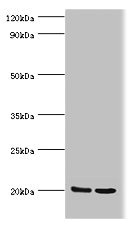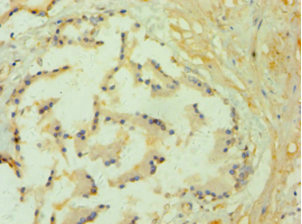GLO1 Antibody
-
货号:CSB-PA871864DSR1HU
-
规格:¥440
-
促销:
-
图片:
-
Western blot
All lanes: GLO1 antibody at 2μg/ml
Lane 1: HepG2 whole cell lysate
Lane 2: Hela whole cell lysate
Secondary
Goat polyclonal to rabbit IgG at 1/10000 dilution
Predicted band size: 21, 20 kDa
Observed band size: 21 kDa -
Immunohistochemistry of paraffin-embedded human prostate tissue using CSB-PA871864DSR1HU at dilution of 1:100
-
-
其他:
产品详情
-
产品名称:Rabbit anti-Homo sapiens (Human) GLO1 Polyclonal antibody
-
Uniprot No.:Q04760
-
基因名:GLO1
-
别名:Aldoketomutase antibody; glo1 antibody; GLOD1 antibody; Glx I antibody; GLYI antibody; glyoxalase domain containing 1 antibody; Glyoxalase I antibody; Ketone aldehyde mutase antibody; Ketone-aldehyde mutase antibody; Lactoyl glutathione lyase antibody; Lactoylglutathione lyase antibody; LGUL_HUMAN antibody; Methylglyoxalase antibody; S D lactoylglutathione methylglyoxal lyase antibody; S-D-lactoylglutathione methylglyoxal lyase antibody
-
宿主:Rabbit
-
反应种属:Human
-
免疫原:Recombinant Human Lactoylglutathione lyase protein (1-184AA)
-
免疫原种属:Homo sapiens (Human)
-
标记方式:Non-conjugated
-
克隆类型:Polyclonal
-
抗体亚型:IgG
-
纯化方式:Antigen Affinity Purified
-
浓度:It differs from different batches. Please contact us to confirm it.
-
保存缓冲液:PBS with 0.02% sodium azide, 50% glycerol, pH7.3.
-
产品提供形式:Liquid
-
应用范围:ELISA, WB, IHC
-
推荐稀释比:
Application Recommended Dilution WB 1:200-1:1000 IHC 1:20-1:200 -
Protocols:
-
储存条件:Upon receipt, store at -20°C or -80°C. Avoid repeated freeze.
-
货期:Basically, we can dispatch the products out in 1-3 working days after receiving your orders. Delivery time maybe differs from different purchasing way or location, please kindly consult your local distributors for specific delivery time.
相关产品
靶点详情
-
功能:Catalyzes the conversion of hemimercaptal, formed from methylglyoxal and glutathione, to S-lactoylglutathione. Involved in the regulation of TNF-induced transcriptional activity of NF-kappa-B. Required for normal osteoclastogenesis.
-
基因功能参考文献:
- GLO1 SNPs, rs1130534 (c.372A>T, p.G124G), rs2736654 (c.A332C, p.E111A) and rs1049346 (c.-7C>T, 5'-UTR) were genotyped. While c.A332C polymorphism was not associated with retinitis pigmentosa (RP), c.372A>T showed an allelic association. Conversely, c.-7C>T showed both genotypic and allelic associations. RP susceptibility may be associated with two of the analyzed GLO1 polymorphisms (rs1130534 and rs1049346). PMID: 30099685
- The active sites of human and staphylococcus glyoxalases I are also different: the former contains one Zn-ion per chain; the latter incorporates two of these ions.. We suggest that only single Zn1-ion plays the role of catalytic center. The newly found differences between the two subfamilies could guide the design of new drugs against S. aureus, an important pathogenic micro-organism. PMID: 28034013
- This study shows that only the GLO1 C-7T polymorphism, and not the GLO1 A419C and ALR C-106T polymorphisms, is associated with carotid atherosclerosis in Chinese patients with type 2 diabetes. PMID: 21294693
- The expression of glyoxalase system member glyoxalase 1 (GLO1) in melanoma cells is downregulated by miR-137. siRNA targeting of GLO1 mimicks inhibition of melanoma cell proliferation caused by miR-137 overexpression. Re-expression of GLO1 restores miR-137-mediated suppression of melanoma cell proliferation. PMID: 29307109
- The critical role of glyoxalases as regulators of tumorigenesis in the prostate through modulation of various critical signaling pathways, and an overview of the current knowledge on glyoxalases in bladder, kidney and testis cancers is reviewed.(GLO1, GLO2) PMID: 29385039
- Inhibition of GLO1 in Glioblastoma Multiforme Increases DNA-AGEs, Stimulates RAGE Expression, and Inhibits Brain Tumor Growth in Orthotopic Mouse Models PMID: 29385725
- current research highlighted the Glo-I/AGE/RAGE system as an interesting therapeutic target in chronic liver diseases. These findings need further elucidation in preclinical and clinical studies. PMID: 29156655
- GLO1-knockdown provoked collagen expression, endothelial inflammation and dysfunction and apoptosis which might contribute to vascular damage PMID: 27898103
- expressed in basal epidermis; significantly higher expression in older individuals PMID: 26914966
- Interdependence of GLO I and PKM2 in the Metabolic shift to escape apoptosis in GLO I-dependent cancer cells. PMID: 29225125
- Induced Glyoxalase 1 expression is a common feature in the pathogenesis of oropharyngeal squamous cell carcinoma PMID: 28549423
- The lowering of glycative stress via modulation of RAGE-AGE axis or glyoxalase 1 activity is beneficial for tubular homeostasis and the subsequent prevention and treatment of kidney disease, suggesting the possibility of novel therapeutic approaches which target glycative stress. PMID: 27270765
- Glo-1 responds to dicarbonyl stress to enhance cytoprotection at the transcriptional level through stress-responsive increase of Glo-1 expression. PMID: 27406712
- Glo1, together with Glo2, represents a novel mechanism in prostate cancer progression driven by a PTEN/PI3K/AKT/mTOR signaling pathway. PMID: 27696457
- Gly82Ser and 2184 A/G RAGE polymorphisms were related to the mortality due to the breast cancer and -419 A/C glyoxalase I polymorphism was related to the overall mortality of the patients suggesting their role not only in the risk of breast cancer but also in the outcome of patients with breast cancer. PMID: 28695773
- Reduction of GLO1 activity in atherosclerotic lesions of nondiabetic patients with increased HbA1c is associated with a functional involvement of this protective enzyme in atherogenesis. PMID: 27478003
- Studies suggest that the enhancement of glyoxalase I (GLO-1) is a promising strategy aimed at halting the vicious cycle between chronic kidney disease and increases in glycative stress. PMID: 28106734
- GLO1 on one hand is crucial to maintaining tumor characteristics of malignant cells, and, on the other hand, supports malignant transformation of cells in a hypoxic environment when overexpressed. PMID: 27999356
- GLO1 SNPs are significantly associated with late-onset and drug-resistant epilepsy. PMID: 27000251
- MS5 induced hydrogen peroxide-mediated c-Jun-dependent Glo1 up-regulation which resulted in a decrease in the Argpyrimidine-modified Hsp70 protein level which triggered EMT in a novel mechanism involving miR-21 and SMAD signalling PMID: 26784015
- MMP-9 and Bcl-2 expression levels were dramatically decreased by addition of methylglyoxal or inhibition of GLOI. These findings may provide a new approach for the treatment of breast cancer. PMID: 26618552
- Data suggest Glo1's effects on anxiety-like behavior are centrally mediated as overexpression of Glo1 in neurons was sufficient to increase anxiety-like behavior PMID: 26711908
- Studies indicate that the most extensively investigated The most extensively investigated glyoxalase enzymes are glyoxalase I and glyoxalase II (Glo1 and Glo2). PMID: 26552067
- The GLO1 variations were not the source of association of the BTBD9 locus with restless legs syndrome. PMID: 26298793
- Glo1 is involved in the Min-U-Sil 5 crystalline silica-induced BEAS-2B cell mitochondrial apoptotic pathway. PMID: 25841781
- Two classes of the metalloenzyme GlxI exist and vary in their metal dependencies PMID: 25557363
- GLO1 activity affects the overall burden of carotid artery atherosclerosis. PMID: 24767709
- individuals with the GLO1 A /E genotype, PON192/QR-RR genotypes and PON55/LM-MM genotypes had a significantly higher risk of cerebral cavernous malformations compared with the other genotypes. PMID: 26122242
- This study demonstrated that the GLO1 C332 (Ala111) allele confers autism vulnerability by reducing brain glyoxalase activity and enhancing advanced glycation end-products. formation PMID: 25201284
- This review describes the role of GLO1 in tumor cell proliferation and survival, and the potential of GLO1 as a biomarker for tumor diagnosis and as a target for anticancer drug development. [review] PMID: 25342507
- Significant differences in the allelic and genotype frequencies of GLO1. PMID: 25407489
- In ApoE(-/-) mice with or without diabetes, GLO1 overexpression did not lead to decreased atherosclerotic lesion size or systemic inflammation. PMID: 25139743
- Data show that GlxI is a novel substrate of TG2 and TG2 catalyzes either polyamine conjugation or deamidation depending the presence of polyamines. PMID: 24494193
- results suggested involvement of accumulated dicarbonyls and/or pentosidine in the pathophysiology of schizophrenia patients carrying Glyoxalase-1 mutations. PMID: 24995521
- Study demonstrates that GLO1 is a novel metabolic oncogene of the 6p21 amplicon, which promotes tumor growth and aberrant transcriptional signals via regulating cellular metabolic activities for energy production. PMID: 24662817
- GLO1 lessened inhibitory phosphorylation of eNOS (Thr495) by reducing glycative stress. Study demonstrates that blunting glycative stress prevents the long-term impact of endothelial dysfunction on vascular aging. PMID: 24612481
- GLO1 is prevailingly expressed in cutaneous neoplasms of higher malignancy and contributes to the progression of squamous cell carcinoma PMID: 25184957
- Weak association of glyoxalase 1 (GLO1) variants with autism spectrum disorder PMID: 24671236
- Suggest Glo1 pathway activation is required for cell proliferation and cell survival of hepatocellular carcinoma cells carrying Glo1 genetic amplification. PMID: 24966916
- Report association of GLO1 (rs4746) polymorphism with markers of endothelial activation in diabetes mellitus. PMID: 24908234
- Overexpression of GLO1 in bone marrow cells is sufficient to overcome the defective neovascularization that is characteristic of diabetes. PMID: 24259499
- Overall, thus Glo1 might be essential for hepatocellular carcinoma progression and can be designated as a potential therapeutic target for hepatocellular carcinoma in the future. PMID: 24158671
- level by differently inhibiting GI via NF-kappaB.Superoxide anion and hydrogen peroxide induced a diverse apoptosis. PMID: 24002659
- we provided evidence of the biological plausibility of Glyoxalase 1 polymorphism, either alone or in combination with other ones, all related to oxidative stress control that represents a key event in PCa development and progression. PMID: 24040147
- GLO1 was the only protein which consistently varied according to the metastatic potentials of SN12C clones. GLO1 was increased in high metastatic cell lines by western blot analysis. PMID: 23982595
- data suggest a possible association of C332C-genotype of the glyoxalase 1 gene with diabetic neuropathy in type 2 diabetes, supporting the hypothesis that methylglyoxal might be an important mediator of diabetic neuropathy in type 2 diabetes. PMID: 23775136
- GLO1 expression level in prostate cancer tissues correlates with pathological grade and proliferation rate. PMID: 24105621
- Data suggest that GLO1 activity is lower in blood (in whole blood assay) in type 1 or type 2 diabetes with painful peripheral diabetic neuropathy as compared to control subjects; Glo1 activity negatively correlates with duration of type 1 diabetes. PMID: 23351995
- The Ala111Glu glyoxalase gene polymorphism did not have an effect on glyoxalase 1 activity in either the type 1 diabetes mellitus or healthy control group. PMID: 23360186
- No evidence of an association of RAGE or glyoxalase I single nucleotide polymorphisms with pathological pregnancy. PMID: 22771726
显示更多
收起更多
-
蛋白家族:Glyoxalase I family
-
数据库链接:
HGNC: 4323
OMIM: 138750
KEGG: hsa:2739
STRING: 9606.ENSP00000362463
UniGene: Hs.268849
Most popular with customers
-
-
YWHAB Recombinant Monoclonal Antibody
Applications: ELISA, WB, IF, FC
Species Reactivity: Human, Mouse, Rat
-
Phospho-YAP1 (S127) Recombinant Monoclonal Antibody
Applications: ELISA, WB, IHC
Species Reactivity: Human
-
-
-
-
-























